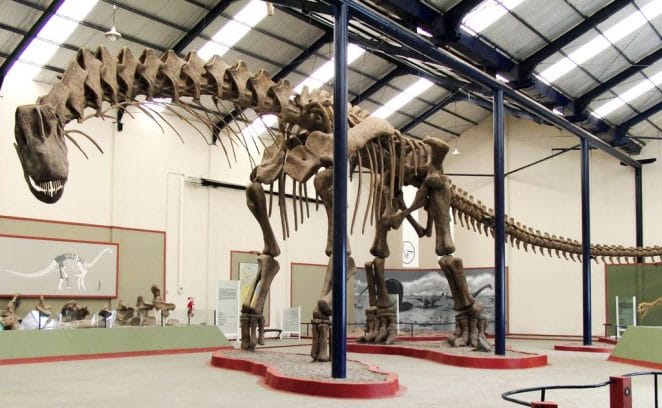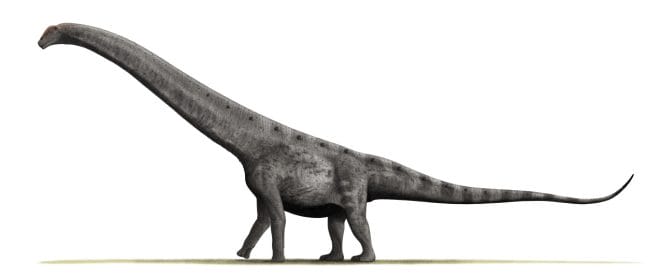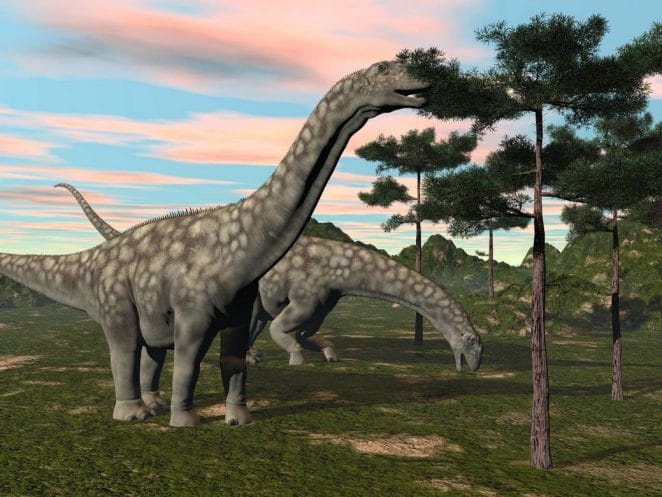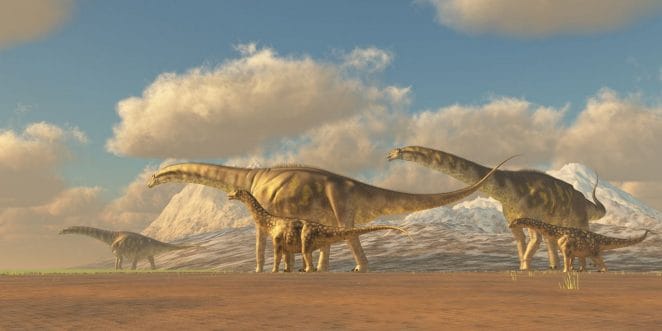Argentinosaurus is a genus of gigantic sauropod dinosaurs that lived in what is now Argentina during the Late Cretaceous period. Argentinosaurus, the largest land animal yet discovered, is a member of a family that originated in Gondwana, an ancient supercontinent’s southern continent. When Argentinosaurus, the largest dinosaur in the world, was found in Argentina in 1987, it shook palaeontology to its core.

Learn more interesting facts about the Argentinosaurus.
1: Argentinosaurus quick facts:
Name: Argentinosaurus (Greek for “Argentina lizard”); pronounced AR-gent-eeno-sore-us
When it lived: Late Cretaceous, 90 million years ago
Type of dinosaur: Sauropod
Location: Argentina
Habitat: Terrestrial habitats.
Length/Weight: 35 meters/70000kg
Diet: Herbivorous
Distinguishing Characteristics: It had a 29-foot-long neck with a little head. Long tails and powerful feet helped support their weight.
Named by: Bonaparte and Coria (1993)
2: What Did Argentinosaurus Look Like?
Argentinosaurus was a massive dinosaur with a 29-foot-long neck, a small head, a long tail, and four powerful legs. The weight of this dinosaur was measured in tonnes, and only a few bones and bone fragments from a single individual have been unearthed to yet. Since there isn’t a full skeleton of this giant dinosaur yet, scientists can only guess at its length and weight because they don’t have enough facts and information.

Palaeontologists won’t know for sure how big Argentinosaurus was or what it looked like until a complete skeleton is found. However, the bones that have been found and comparisons to other Sauropods show that this dinosaur was one of the biggest ever found.
3: What does the name Argentinosaurus mean?
The name Argentinosaurus derives from the Greek language and literally means “Argentina Lizard” in reference to the nation where it was discovered, Argentina. The name “Huinculensis” refers to the fossils’ discovery in the Huincul Formation. Rodolpho Coria and Jose Bonaparte named it in 1993.
4: How do you pronounce ‘Argentinosaurus’?
The name Argentinosaurus is pronounced AR-gent-eeno-sore-us.
5: What did Argentinosaurus eat?

Argentinosaurus was a herbivore. This big sauropod has strong teeth for grinding and consuming the rough plant material prevalent in Cretaceous Argentina. Some experts believe that dinosaurs, particularly this huge Argentinosaurus, were able to grow to such massive sizes due to the rate of their metabolism. It is estimated that an Argentinosaurus could gain up to 100 pounds per day during its adolescence
6: Who discovered Argentinosaurus?
Guillermo Heredia, a rancher from Argentina’s Neuquén Province, found the Argentinosaurus in 1987. José F. Bonaparte and Rodolfo Coria gave the Argentinosaurus the formal name Argentinosaurus huinculensis in 1993.
7: Where did Argentinosaurus live?
Approximately 90 million years ago, Argentinosaurus thrived on the supercontinent Gondwana in what is now Argentina, South America. During that time, the Patagonian desert was a verdant paradise for dinosaurs like Argentinosaurus.
8: When was the Argentinosaurus alive?

It is thought that these dinosaurs roamed the earth between 100 and 96 million years ago. The Argentinosaurus dinosaur is thought to have shared its whole natural history with the Giganotosaurus, another massive predatory dinosaur. These dinosaurs lived in a natural habitat in Argentina, which is now part of South America.
9: What kind of climate did Argentinosaurus inhabit?
As a herbivore, it was hypothesised that Argentinosaurus lived on land formations that were highly forested throughout the late Cretaceous. This environment, as well as the natural history of these groups, was shared with other creatures, such as Titanosaurs, Sauropods, and carnivorous dinosaurs that preyed on adult and juvenile Argentinosaurus on the South American continent.
10: What was Argentinosaurus’s height and weight?
The Argentinosaurus is often considered to be one of the world’s largest beasts. Argentinosaurus were extraordinarily long, with a body length of 30 to 39.7 metres (100 to 130 feet) and a height of 70 feet (21.4 metres)! This creature’s neck was also very lengthy, estimated to be over 29 feet (8.8 metres) long!

The Argentinosaurus is one of the heaviest animals ever discovered. The body mass of this beast has been estimated to be between 50 and 100 tonnes (50000 to 100000kg).
11: Did Argentinosaurus have any predators?
Mapusaurus, one of the biggest known theropods, could have eaten Argentinosaurus. At least seven Mapusaurus were found together, which suggests that this theropod might have hunted in groups to catch big animals like Argentinosaurus.
12: How did the Argentinosaurus protect itself?
Argentinosaurus may have protected itself by slashing at predators with its long tail.
13: How did Argentinosaurus walk?
Argentinosaurus walked on four legs. Due to a scarcity of fossil evidence, little is known about Argentinosaurus’ movement. Some speculate that because this dinosaur was so large and heavy, and had such short legs, it may have had difficulty moving and wouldn’t have been able to sprint, but this is just theory until additional evidence is discovered.
14: How many eggs did Argentinosaurus lay?
The maximum size of a dinosaur egg is limited by physical and biological restrictions. Argentinosaurus most likely came close to exceeding that limit, given its enormous size. According to similarities with the eggs of other titanosaurs, Argentinosaurus eggs were about a foot in diameter, and females deposited up to 10 or 15 eggs at a time, enhancing the chances that at least one hatchling would elude predators and live to adulthood.
15: How fast can Argentinosaurus run?
According to newly discovered data, Argentinosaurus was a slow mover with a top speed of roughly 5 mph (7 km/h) due to its massive size and construction. This dinosaur’s huge feet are thought to have caused a lot of collateral harm as it trampled plants and animals equally.
16: Why is the finding of Argentinosaurus significant?
The unearthing of a new dinosaur is always significant because it aids palaeontologists in learning more about what roamed the earth during prehistoric times and sheds information on how future dinosaur species evolved.
The discovery of hollow bones belonging to Argentinosaurus may help fill in some of the gaps in our knowledge regarding the evolution of sauropod dinosaurs over time. Regrettably, though, because no full skeleton or even just a head of Argentinosaurus has ever been discovered, it is difficult to tell for certain what the dinosaur actually looked like.
The fragmented nature of titanosaur fossils is one of the most irritating aspects of this group of dinosaurs in general. Even when a complete, articulated skeleton is discovered, the skull is typically missing because titanosaur skulls were easily separated from their necks after death.
17: Other interesting Argentinosaurus facts:
- The average Argentinosaurus egg was around the size of a beach ball, according to scientists.
- It is thought that Argentinosaurus took about 15 years to attain adulthood size, making them vulnerable to predators until then.
Sources:Wikipedia





GIPHY App Key not set. Please check settings